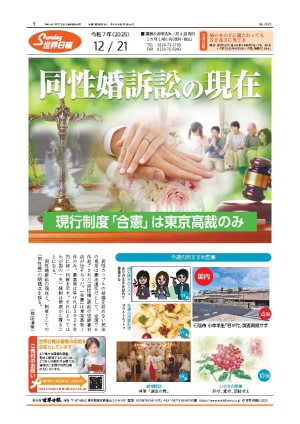白人キリスト教徒、人口の43%に減少 White Christian America shrinks to just 43 percent of population
進歩主義者らによると、調査では白人キリスト教徒は少数派であり、トランプ大統領の支持基盤は縮小している。しかし、宗教右派の有力者らは、このような指摘はかなり誇張されていると主張している。
6日に公表された公共宗教研究所の調査によると、米国人の43%が自身を白人でキリスト教徒と考えている。1976年は81%だった。
同研究所のCEOで、調査報告「白人キリスト教徒の米国」の作成者、ロバート・ジョーンズ氏は、データは「(トランプ氏が)予想に反して勝利したことは、白人キリスト教徒の米国の(復活というよりも)最後のあがきとみた方が分かりやすい」と指摘した。
ジョーンズ氏は調査結果が公表される数日前、アトランティック誌に掲載された記事で「どれだけ多くのキリスト教右派の指導者らが今後4年間、権力の座に就こうと、今後20年間、2016年が白人キリスト教徒の米国が復活した年として祝われる可能性はあまりない。むしろ、今回の選挙は、白人福音派が以前持っていた力を取り戻そうとする中で、一体性と影響力を失った選挙として記憶される可能性が高い」と指摘した。
この減少傾向によって、福音派プロテスタントなどのキリスト教主要宗派の白人人口が影響を受け、2006年以降に信徒数の比率は全体で16%から11%に減少した。同時期に、白人の主流派プロテスタントは18%から13%、白人カトリック教徒は16%から11%に減少した。
減少の理由は、移民、白人キリスト教徒の高齢化、自身を無宗教と考える米国人の増加などにある。
米国で多様性が増していることは、カトリック教会の人種構成の変化からも分かる。25年前はカトリック教徒10人のうちほぼ9人が白人だった。現在の30歳未満の若いカトリック教徒では、ヒスパニック(中南米)系(52%)が白人(36%)よりも多い。
米国の無神論者、不可知論者の割合は増加し続けている。米国人の4分の1以上(27%)が自身を無宗教と考えている。
調査から、民主党内の白人キリスト教徒が大幅に減少していることも分かる。党の支持基盤の29%にすぎない。10年前は50%だった。
一方の共和党では、党員のほぼ4分の3が自身を白人でキリスト教徒と考えている。
家族研究評議会のトニー・パーキンス会長によると、進歩主義者らは、宗教右派が衰退に向かっているのは間違いなく、全国的な主要選挙で敗北したとき、それは顕著になると考えているという。
パーキンス氏は6日、FOXニュース・ラジオの「トッド・スターンズ・ショー」で「ここで肝心なのは、福音派が今回の選挙で及ぼした影響力がそれをよく物語っており、このようなことは今回限りであることを示そうとしていることだ。だが、このような現象は、あらゆる選挙サイクルの中で起きている」と語った。
パーキンス氏は1990年代によく見られた主要紙の見出しについて触れている。キリスト教と、その政界への影響力の衰退を予測したものだ。
「振り返ってみれば1990年代、ワシントン・ポストにこういう記事があった。『絶頂期は終わった。宗教右派の知識人らも会見でこれを認めている。宗教右派は政治的手腕で劣っていると批判されている』。基本的に宗教右派は困難に直面していたが、それは昔の話だ」
(9月6日付)
Progressives say a poll showing white Christians in the minority is evidence that President Trump’s voter base is dwindling, but veterans of the religious right say rumors of the movement’s demise are greatly exaggerated.
The Public Religion Research Institutesurvey released Wednesday found that 43 percent of Americans identify as white and Christian, down from 81 percent as recently as 1976.
Robert P. Jones, CEO of the research institute and author of “The End of White Christian America,” said the data suggest that Mr. Trump’s “unlikely victory is better understood as the death rattle of White Christian America” rather than its resuscitation.
“Twenty years from now, there is little chance that 2016 will be celebrated as the revival of White Christian America, no matter how many Christian right leaders are installed in positions of power over the next four years,” Mr. Jones wrote in an article in The Atlantic a few days before the survey was published. “Rather, this election will most likely be remembered as the one in which white evangelicals traded away their integrity and influence in a gambit to resurrect their past.”
The downward trend affected the white population of each of the major Christian denominations, including evangelical Protestants, whose overall share of the population dropped from 16 percent to 11 percent since 2006. White mainline Protestants fell from 18 percent to 13 percent over that same span, and white Catholics from 16 percent to 11 percent.
Reasons for the decline include immigration, an aging white Christian population and increases in the number of Americans who identify as religiously unaffiliated.
America’s increasing diversity is captured in the ethnic transformation of the Catholic Church. Twenty-five years ago, nearly nine out of 10 Catholics were white. Today, Catholics younger than 30 are more likely to be Hispanic (52 percent) than white (36 percent).
Atheists and agnostics continue to comprise a larger share of the U.S. population. More than one-quarter (27 percent) of Americans today identify as religiously unaffiliated.
The survey also shows that the number of white Christians in the Democratic Party has declined dramatically. The demographic makes up just 29 percent of the party’s base, compared with 50 percent one decade ago.
Roughly three-quarters of Republicans still identify as white and Christian.
Tony Perkins, president of the Family Research Council, said progressives predict the end of the religious right like clockwork, especially when they lose a major national election.
“The whole point here is to try to suggest that the influence that evangelicals have in this election is - take a snapshot, take a good picture of it, because you’re not going to see it again,” Mr. Perkins said Wednesday on Fox News Radio’s “Todd Starnes Show.” “Look, this is a phenomenon that occurs every election cycle.”
Mr. Perkins recalled headlines in major newspapers throughout the 1990s forecasting the fall of Christianity and its influence in the political arena.
“I went back and just looked,” he said. “Back in 1990, there was a story from The Washington Post saying, ‘The bloom is off, religious right scholars at conference agree. Movement criticized for lacking political finesse.’ Basically, the religious right has fallen on hard times and it’s going away.”
September 6, 2017





